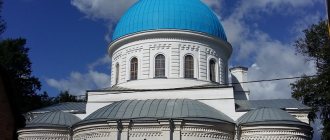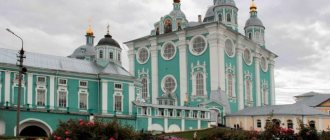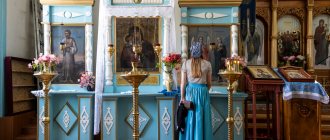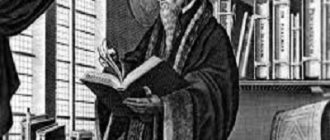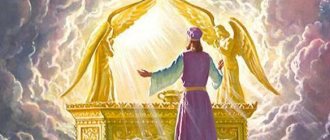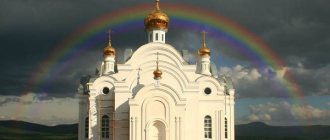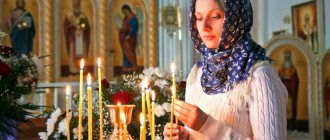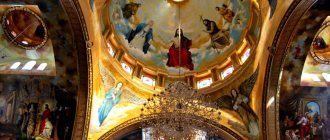Short story
This is an ancient, but still not original, tradition that does not go back to the origins of the Church. Christians did not have an altar barrier at all, at least until the 4th century.
For the sake of human weakness
According to the legend cited in the ancient lives of St. Basil the Great, the custom of the altar curtain was first introduced under this bishop of Caesarea of Cappadocia. His celebration of the Liturgy was always accompanied by a special Divine action, which marked the accomplished Descent of the Spirit onto the Holy Gifts - the shaking of the image of a dove above the throne.
One day, having said secret prayers, the saint did not see the usual sign. Wondering why he angered the Lord, Vasily looked around at his co-servants and saw one of the deacons looking at a woman standing nearby.
Then he ordered the deacon to leave, imposing penance on him. He also established that the altar should henceforth be hidden by a curtain.
Altar partition of the ancient basilica “Afenteli” on the island of Lesbos, 4th century. Reconstruction of A.Orlandos.
Against iconoclasm
Subsequently, special openwork grilles also appeared to separate the altar. But the installation of holy images on them began no earlier than the 9th century, after the 7th Ecumenical Council. Then the iconoclastic heresy was condemned, and the icons of Jesus Christ, the Mother of God, and the saints not only demonstratively returned to the churches (from where the heretics had thrown them out), but began to accompany the main Sacrament, the Eucharist, if on the altar barrier.
But this barrier itself was not high until the 11th-13th centuries; believers clearly saw what was happening during the celebration of the Eucharist.
Longline
Initially there were no more than three rows of icons. These were not necessarily painted icons.
Interesting fact
For example, in the church of Santa Maria in Valle in the Italian city of Abruzzi ( 13th century), a wooden iconostasis of three rows is known.
Finally, by the 14th century. multi-tiered barriers appear, completely hiding the altar. Many church historians suggest that this may have been due to the rise of Byzantine spirituality at the time.
Altar barrier in the Church of Santa Maria in Valle Abruzzi. Italy. The main structure dates back to around 1080, as recorded on the pillars of the portico
In Rus'
Here, the tradition of high iconostases, according to many historians, dates back to the 14th century. There are different opinions about the reasons for the spread of such altar barriers:
- the phenomenon is associated with the introduction of the Jerusalem Liturgical Rule (from the 14th century), with longer services, including all-night vigils, and more stringent disciplinary rules; so the idea could arise, on the one hand, of separating the altar from the part of the temple where the laity were, on the other hand, about their spiritual education, upbringing, with the help of many holy images;
- many also say that the reason was the prevalence of wooden rather than stone churches in Rus' at that time; the inability to decorate wooden churches with frescoes - painting on stone - was compensated by an increase in the number of icons.
However, there is no established opinion about the reasons for increasing the number of rows. It is only clear that with an increase in the number of icons, the question inevitably arises about the symbolism of the iconostasis itself.
Iconostasis of the Assumption Cathedral. Moscow Kremlin
Symbolism
So, from a “mere” barrier separating the altar from the rest of the church space, it becomes a special element of the temple decoration.
Royal Doors
They are located in the center, and are called so because the clergy pass through them, the Holy Gifts are carried out, that is, the King of the world Himself comes to the people. There are usually images on the sections:
- Annunciation;
- Evangelists.
This is a symbol of the fact that the Incarnation of the Son of God, His Word, transmitted by the disciples, opens Paradise to believers.
The Byzantines also have images:
- svtt. John Chrysostom, Basil the Great , creators of the rites of the liturgy; after all, the Sacrament of the Eucharist unites a person with God;
- prophet Moses and the first priest of the Jewish people, Aaron; this is, as it were, a memory of the fact that initially, from the 4th century, the gates were a curtain, similar to the one that separated the Holy of Holies of the Jerusalem Temple.
Royal Doors
However, there is an important difference: the New Testament veil opens, revealing Paradise. This is how St. writes about it. John Chrysostom:
“When the sacrifice is worn out and Christ, this divine sheep, is offered as a sacrifice, when you hear: let us all pray together, when you see that both halves of the curtains are rising, then imagine that the heavens are opening and angels are descending from above...”
Window to Heaven
That is why the symbolic meaning of the altar barrier comes down to... the absence of a barrier.
It separates the altar only externally: in fact, it is a series of images of God, saints, who help to renounce the vanity of the world, to spiritually unite with Christ - with spiritual help, as if through the mediation of those whose images enter from the icons. These are not boards or paints, but a kind of “window” through which the heavenly world actually comes into contact with earthly life.
It is no coincidence that rows of icons are also called “ranks,” that is, in the same way as the hierarchy of Angels (Angels, Cherubim, Seraphim, etc.), as well as people who especially pleased God (ranks of saints, righteous, faithful, etc.) are called.
Theological implications
The iconostasis does not actually “separate” the nave from the Holy of Holies; rather, it brings them together. The iconostasis is the link between the sky (Holy of Holies) and the nave (Holy Place). Therefore, everything on the iconostasis is symbolic. Icons of Christ, the Mother of God, various saints and feasts are present because Christ, the Mother of God, the saints, etc. guide us and lead us into the Holy of Holies. Therefore, the characters of the icons on the iconostasis lead us to heaven, and therefore the iconostasis connects and does not separate. The icons on the iconostasis are also windows and bridges to the sky (although all icons, anywhere, are windows and bridges to the sky). Therefore, in a sense, the iconostasis represents Christ, who is the connecting link, the door between the two spheres. The ideal explanation of the iconostasis and its unifying purpose can be found in Hebrews 10:19-20: “Therefore, brothers, since we are confident of entering into the sanctuary through the blood of Jesus, in a new and living way, which He made known to us through the veil, that is, through His flesh.” .
Ranks of the iconostasis
There are from 2 to 5 rows, sometimes there are also 7, or even more.
In what order are the tiers of the iconostasis most often arranged in a church?
This arrangement represents in a special way the connection of heaven and earth: after all, the semantic center is the so-called Deesis, a row where Christ is presented with the saints ahead. The aspirations of the prophets and forefathers are directed towards Him; a special series represents His earthly life.
Scheme of the Old Russian iconostasis
What is the name of the first row of the iconostasis?
Usually the bottom row is considered first. It is called local because the temple image is located here, so the dedication of the church can be easily “read” from the icon next to the image of Christ, to the right of the royal doors. In addition, the series necessarily includes an icon of the Mother of God and especially revered saints of the temple and city.
Next rows
Above the local one is the main row of the iconostasis, Deisis (in Greek - prayer). The center of the row is Christ, whose icon is located above the royal doors. Standing before him are the Mother of God, John the Baptist, the Apostles (most often Peter and Paul), and Angels. Other saints may also be depicted here. The peculiarity of the rite is the prayer position, the turning towards Christ of all the depicted saints of God: their heads are bowed, their hands are stretched out to the Lord.
Iconostasis in the cave of Elijah the Prophet in Sinai (Egypt).
The ranks follow even higher:
- festive - its icons represent the earthly life of the Lord;
Until the 16th century in this row one could see several icons representing the Passion of Christ. Now, of these, only the image of the Crucifixion has been preserved here.
- prophetic - here are the icons of the prophets who foretold His coming; a believer familiar with their writings recognizes the saints of God by the words written on the scrolls held by the saints;
- forefathers – icons depict ancient forefathers.
Since the 17th century first in Ukraine, then throughout Russia, very high iconostases with 7-8 tiers appear. There are additional rows dedicated to:
- Passion of Christ;
- death of the Apostles.
There were some temples where, below the local row, literally at floor level, there were images of pagan philosophers who did not know God, but, perhaps, unconsciously anticipated the coming of the Messiah.
Full five-row iconostasis
Festive row.
The next tier of the iconostasis represents the New Testament period, namely the events associated with the earthly life of Christ. However, the holiday series is not a consistent illustration of the gospel story. Its content was determined by the context of the iconostasis as a single whole, as well as by various nuances of understanding the daily, weekly and annual cycles of worship. In the festive series, only those events are depicted that are significant stages of the Divine economy of salvation. Usually this series consists of icons of the Resurrection, the main twelve feasts (Christmas, Epiphany, Presentation, Entry into Jerusalem, Ascension, Transfiguration, Nativity of the Virgin Mary, Presentation into the Temple, Annunciation, Dormition), as well as two ecclesiological holidays of the moving cycle: Pentecost and Exaltation of the Cross .
Brief description: what types of iconostases are there?
It is usually believed that there are two types of iconostases: paneled or framed. In addition, there are small iconostases intended for camp temples or simply private prayer while traveling.
Tyablovy
The beams are called the beams from which the frame is assembled. There are icons on these beams. In Rus' this is the most common form of altar barrier
Frame
Such iconostases began to appear throughout Russia in the 17th century. The icons are not located on beams, but are set in magnificent frames, in fact, independent works of church art. Sometimes sculptures become part of such frames, which is not very typical for Orthodox churches.
Iconostasis of the Intercession Church of St. Daniel's Monastery.
Marching
In another way, it is called a “folding”, having a central part to which the doors are hinged. It can be folded for transport.
Typically, camping iconostases are wooden or metal. But now there are also, in fact, curtains with images of saints, corresponding in size to the temple ones. In the center is a special curtain, the royal gates.
Material
Most often this is wood or stone.
Stone
This is a “capital”, solid barrier on which icons of saints are written.
Stone iconostasis. Orthodox monastery of Hosias Lucas in Phokis 1030-40s. Greece
Wooden carved
It occurs most often. If the iconostasis is tyablo, the beams are decorated with carvings; if the iconostasis is framed, it is a series of wooden artistically designed frames for icons.
Gold
Wood is often covered with gold, as this color is a traditional symbol of the Kingdom of Heaven.
Porcelain
It is believed that one of the first appeared in the New Jerusalem Monastery near Moscow, in the 2nd half. XVII century The founder of the monastery, Patriarch Nikon, tried to accurately reproduce the marble interiors of the Jerusalem Church of the Resurrection, but the high cost of marble led him to the decision to make the altar barriers of the nine side chapels of the monastery church from porcelain. The work was carried out by Belarusian craftsmen.
Ceramic iconostasis in the Trinity Cathedral in the city of Shchelkovo
Recommendations
- Bock, Franz Johann Joseph, The Veils of the Ciborium of the Altar
(translated section of his
Organ für Christliche Kunst
), Ecclesiologist, Volume 26, 1868, Ecclesiological Society/Stevenson, Google Books - "The Grove", van Hemeldonck, G., "Siborium (ii)". In Grove Art Online. Oxford Art Online, subscription required, (accessed 25 April 2011).
- Ephthalia Rentetsi, Le iconostasis Delle Chiese greche in Italy
, Athens 2008
| Wikisource has the text of the 1911 Encyclopædia Britannica article Iconostasis . |
Construction of the iconostasis in the temple
Nowadays there are barriers of an ancient form, of two tiers, or higher ones, including a larger number of rows, most often 5.
The most ancient iconostasis
Many consider the altar barrier of the Church of St. Sophia in Constantinople (VI century) to be such. It consisted of 12 columns (according to the number of Apostles). Between them, according to the memoirs of contemporaries, there were images of the Lord, the Virgin Mary, and the Apostles.
Hagia Sophia is one of the most visited attractions in Istanbul. According to historical sources, before the defeat by the crusaders, the altar was made of pure gold, painted with enamel and decorated with precious stones. In the middle of the central nave stood an ambo, skillfully made of ivory, silver and colored marble. The dome over the pulpit was made of gold and decorated with precious stones. There were legends about the wealth of the cathedral. Contemporaries claimed that the sacristy alone contained 40,000 pounds of silver. Photo 2010.
Biggest
Its location is the Cathedral of the Romanian Orthodox Church. It has four tiers with a total height of almost 17 m and a length of 23. 45 icons are made on stone using mosaic and fresco techniques. Total area – 407 sq.m.
Highest
It is located in the Cathedral of the Nativity of Christ in Novokuznetsk. The temple was consecrated on August 23, 2012. There are 170 holy images here, it is not only the tallest (with the size of a five-story building), but also the largest in the world in terms of the number of images.
Famous
Altar barriers are known not only for their size - many of them belong to great masters, are associated with historical events or are made using a unique technique.
Ionostasis of the Trinity Cathedral of the Trinity-Sergius Lavra
Trinity Cathedral of the Trinity-Sergius Lavra
It dates back to the 15th century, and was created by St. Andrey Rublev with his students.
Annunciation Cathedral of the Moscow Kremlin
It is considered the most ancient (beginning of the 15th century) of those currently existing in the Russian Church, its creators are Theophanes the Greek, St. Andrey Rublev.
Assumption Cathedral of the Moscow Kremlin
His images were originally painted by the master Dionysius in the 15th century, and later rewritten by masters of the 17th century, under Tsar Alexei Mikhailovich.
Iconostasis of the Peter and Paul Cathedral in St. Petersburg. Right side
Peter and Paul Cathedral
It is atypical, having the shape of a triumphal arch. Such an artistic decision more than once aroused criticism from contemporaries - after all, according to many, such a demonstration of imperial greatness is hardly appropriate in a temple.
St. Isaac's Cathedral
It is made in the style of classicism, made of stone. The images are separated by columns.
Crystal iconostasis in Dyatkovo
Even before the revolution, the plant in this city of the Bryansk region was considered the “crystal capital” of the country, because the largest crystal plant was located here. It is also the only church with a crystal iconostasis. It was destroyed after the revolution, but rebuilt in 2003 - also with an altar barrier made by the craftsmen of the crystal factory. Now she is the only one in the world.
The iconostasis, destroyed in 1929, was located in the Church of the Transfiguration of the Lord in Dyatkovo. In 1810, the temple was built with money and on the initiative of Ivan Akimovich Maltsov, the founder of a crystal factory at a spring near the village of Dyatkovo (now Bryansk region). And in 1855, his son, Sergei Ivanovich Maltsov, installed a new iconostasis inside the temple - a crystal one.
Categories
Chapel of the holy icon of the Smolensk Mother of God in the Assumption Cathedral in Smolensk.
A Moscow Baroque screen of icons in the Trinity Lavra in Sergeev Posad There are rules regarding who can enter or leave the sanctuary (altar) and through which door. Neither the Beautiful Gate (the Holy/Royal Doors are the central doors) nor the space between it and the altar can be used by the laity under any circumstances, although infants are carried into the altar through them in the "churching" rite, if they are boys or girls, the baby is simply presented at the door.[2]Bishops may enter through the Beautiful Gate at any time; priests and deacons can only do this at certain times during the service when the Gate is open (but during Bright Week they always enter and exit through it). Everyone else enters the sanctuary through the side doors.
In a monastery, only the abbess and senior nun are allowed to enter the sanctuary (altar), and they can only enter through the side doors. The Mother Superior can enter at any time, but other nuns need a blessing to enter.
Iconostasis at Holy Trinity Cathedral in Chicago, Illinois
Male parishioners who are generally permitted to enter the sanctuary include those involved in the governance of a particular church, i.e., cantors and choristers, altar servers/novices, church and vestry custodians, etc.
In Romanian tradition, on the day of the consecration of the altar in the church, the laity, including women, were allowed to enter and venerate the altar before the Vespers of the consecration began. These guidelines have been developed over many centuries, with both theologically symbolic and practical reasons for them.[ citation needed
]
Home iconostasis
The Orthodox, knowing that the family is a small church, strive to arrange a corner here, which was previously called “red”. This was usually the east side of the house. However, now it is not always possible to maintain tradition.
How to arrange icons in a home iconostasis correctly?
About the same as it is done in the temple.
All icons are usually located around the image of Christ. Above is an icon of the Holy Trinity or a cross, if there is one. On the right is the image of the Virgin Mary. On the sides are placed images of saints revered by the family.
There is no obligatory “set” of icons of God’s saints; everything is determined by the believer himself and his preferences. At the same time, you should not “collect” icons or place images of saints at home that you will not pray to.
Sample of a home iconostasis
Straight and angular
The images can be on the wall, or in the corner, then appropriate shelves are needed.
How to make an iconostasis with your own hands: video
Many people buy them at churches or in specialized stores. You can also make a shelf for icons yourself, from wood or plywood. Sometimes icons are simply hung on the wall. Tricks from the master in the video: “Shelf in an hour”:
Deesis series.
The semantic center of this series is the icon of the Savior, represented, as a rule, in the image of a formidable Judge who appeared to judge the world. To the right and left of Jesus Christ are the Mother of God and John the Baptist. They are followed by archangels, saints, apostles, martyrs, saints, i.e. a host of saints, represented by all orders of holiness. The main theme of the Deesis rite is the church’s prayer for peace. Representatives of the earthly world who have achieved holiness and entered the Kingdom of Heaven, forming the Heavenly Church headed by Christ, prayerfully come before the throne of Christ the Judge, asking for leniency towards the earthly church gathered in the temple.
